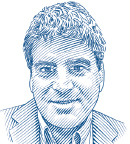
Kevin Knopf, MD, MPH

Charles L. Bennett, MD, PhD, MPP
Biosimilars are biologic products similar to the parent (branded) molecule in structure and function—such as erythropoietin and filgrastim (Neupogen).1 To truly bend the cost curve, we want to see a dramatic economic savings achieved as oncology biosimilars for rituximab (Rituxan), trastuzumab (Herceptin), and bevacizumab (Avastin)—the next expected oncology biosimilars—are introduced to the U.S. market.
Although a report from investigators at RAND optimistically estimates that biosimilars in oncology will achieve $44.2 billion in savings from 2014 to 2024 in the United States, this model had overly optimistic assumptions.2 We think a more likely outcome is to advise oncologists to “curb your enthusiasm.”3
The cost savings achieved are much less than oncologists and insurers in the United States would hope. If there is no difference in meaningful clinical outcome in oncology (ie, overall survival, quality of life) or toxicity, a price premium is difficult to justify, particularly if one applies the principles of distributive justice and a desire to minimize financial toxicity to the individual patient and the health-care system in general.
Relative Cost Differences
The current situation in the United States in the biosimilar market (filgrastim-sndz [Zarxio] is the only marketed biosimilar, with a 10% discount) differs from that in Europe (27 marketed biosimilars, with 8 filgrastim biosimilars, accounting for 65% of the market share in the European Union countries and a 40% discount). When we compare the value of a medicine in the United States, we look at the relative cost savings. For example, in general medicine, we can examine two medicines for gastroesophageal reflux disease: esomeprazole (Nexium) and generic Prilosec (omeprazole)—the generic medicine is 2% of the cost of the branded medicine, with a relative cost savings of 98%.
“The cost savings achieved [with biosimilars] are much less than oncologists and insurers in the United States would hope. ”— Kevin Knopf, MD, MPH, and Charles L. Bennett, MD, PhD, MPP
Tweet this quote
In oncology, we can sometimes see the comparable medicine (generic vs brand) with dramatic cost differences—paclitaxel (generic) at $200 a dose vs nab-paclitaxel (branded; Abraxane) at $10,000 a dose is a cost savings of 99.8%—or we can compare generic leucovorin at $32 a dose vs branded leucovorin (Fusilev) at $1,284 a dose, with a relative cost savings of 97.5%. However, one has only to look at imatinib (Gleevec) for a different picture (branded Gleevec is $145,000 per year, whereas generic imatinib is $140,00 per year, a 1% discount). Although cost savings of 99.8% and 97.5% might actually help bend the cost curve, it is disconcerting to learn that the biosimilar version of drugs will be 85% of the cost of the branded version, or only 15% less expensive—ie, that the relative cost difference of biosimilars will be only 15%. Biosimilars will be more like generic imatinib than generic paclitaxel, hardly bending the cost curve at all.
Complicating Matters Further
The regulatory market and legal hurdles in the United States are more complex than those modeled by the RAND report. Additionally, there is a run up in the price of the branded drug in the years prior to introduction of the biosimilar; for instance, Gleevec had seven price increases from its $70,000 per year cost during the past 2 years of patent protection. Estimates by RAND were for 100% substitution of biosimilar for brand; this has not been the case in other countries and is unlikely to be the case in the United States, where there is sometimes a financial disincentive to use a less expensive version of a drug. The cost of a “patent dance” involving exchange of proprietary information prior to regulatory approval of biosimilars and extensive patent litigation after regulatory approval will ultimately delay marketing of a biosimilar and also lead to much more expensive biosimilars in the United States vs Europe. Thus, cost savings that might have otherwise been achieved by biosimilars will not be seen.
By finding opportunities to lower the cost of cancer care, we hope that the cost curve can bend. Sadly, biosimilars will not bend the cost curve to any meaningful extent, despite early optimism generated by the RAND report. The Trump Administration and the Congress must develop rationale policies and legislation if biosimilars are to lead the way forward for affordable cancer care.4 ■
Dr. Knopf is Medical Director, Cancer Commons and Assistant Professor, University of South Carolina School of Pharmacy, Columbia, and Dr. Bennett is Josie M. Fletcher Professor of the SmartState Center for Medication Safety and Efficacy, University of South Carolina, Columbia.
DISCLOSURE: Drs. Knopf and Bennett reported no conflicts of interest.
REFERENCES
1. Bennett CL, Chen B, Hermanson T, et al: Regulatory and clinical considerations for biosimilar oncology drugs. Lancet Oncol 13 e594-e605, 2014.
2. Mulcahy AW, Predmore Z, Mattke S: The cost savings potential of biosimilar drugs in the United States. RAND Corporation; 2014. Available at https:// www.rand.org/content/dam/rand/pubs/perspectives/PE100/PE127/RAND_ PE127.pdf. Accessed May 15, 2017.
3. Yang YT, Chen B, Bennett CL: Biosimilars—Curb your enthusiasm. JAMA Oncol. June 8 2017 (early release online).

